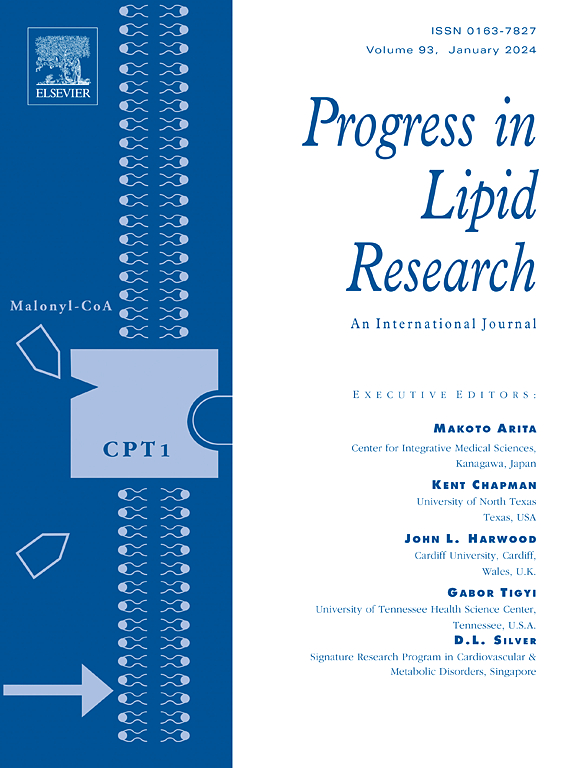Betaine lipids: Biosynthesis, functional diversity and evolutionary perspectives
IF 14
1区 医学
Q1 BIOCHEMISTRY & MOLECULAR BIOLOGY
引用次数: 0
Abstract
Betaine lipids (BL) are relatively understudied non‑phosphorus glycerolipids. They are predominantly found in algae but have also been detected in other unicellular eukaryotes, fungi, bacteria, and some bryophytes and pteridophytes. These extraplastidial lipids are considered as substitute for phospholipids in organisms, particularly under phosphate (Pi) deficiency. This review provides a broader perspective on the roles and functions of BL, revealing their functional diversity across species and environments. It also discuss the biosynthetic pathways of BL. Indeed, the pathway for DGTS (1(3),2-diacylglyceryl-3(1)-O-4′-(N,N,N-trimethyl)-homoserine), the most widespread and studied BL form, is completely known, whereas the pathway for DGTA (1(3),2-diacylglyceryl-3(1)-O-2′-(N,N,N-trimethyl)-β-alanine) is only partially understood. In this review, the role of the BTA1 gene, responsible for the synthesis of DGTS, is discussed. It is revealed to be essential in DGTA synthesis as it enables the production of its intermediate, DGTS. A phylogenetic analysis, conducted on BTA1 gene, does not seem to link the phylogenetic position of BTA1 with the BL species produced but confirms the distribution trends, with a BL diversification in marine environments and the gradual disappearance of DGTS in the evolution of the green lineage. Further research is needed to elucidate the specific roles and biosynthetic pathways of BL across different species.
甜菜碱脂:生物合成、功能多样性和进化观点。
甜菜碱脂(BL)是研究相对较少的非磷甘油脂。它们主要存在于藻类中,但也存在于其他单细胞真核生物、真菌、细菌和一些苔藓植物和蕨类植物中。这些胞外脂质被认为是生物体中磷脂的替代品,特别是在磷酸盐(Pi)缺乏的情况下。本文综述了BL在不同物种和环境中的作用和功能,揭示了它们的功能多样性。它还讨论了BL的生物合成途径。事实上,DGTS(1(3),2-二酰基甘油-3(1)- o -4'-(N,N,N-三甲基)-纯丝氨酸)的途径是完全已知的,而DGTA(1(3),2-二酰基甘油-3(1)- o -2'-(N,N,N-三甲基)-β-丙氨酸)的途径只是部分了解。本文就BTA1基因在DGTS合成中的作用作一综述。它在DGTA合成中是必不可少的,因为它使其中间体DGTS的生产成为可能。通过对BTA1基因的系统发育分析,BTA1基因的系统发育位置似乎与产生的BL物种没有联系,但证实了其分布趋势,即在海洋环境中BL多样化,而在绿色谱系的进化过程中DGTS逐渐消失。不同物种间BL的具体作用和生物合成途径有待进一步研究。
本文章由计算机程序翻译,如有差异,请以英文原文为准。
求助全文
约1分钟内获得全文
求助全文
来源期刊

Progress in lipid research
生物-生化与分子生物学
CiteScore
24.50
自引率
2.20%
发文量
37
审稿时长
14.6 weeks
期刊介绍:
The significance of lipids as a fundamental category of biological compounds has been widely acknowledged. The utilization of our understanding in the fields of biochemistry, chemistry, and physiology of lipids has continued to grow in biotechnology, the fats and oils industry, and medicine. Moreover, new aspects such as lipid biophysics, particularly related to membranes and lipoproteins, as well as basic research and applications of liposomes, have emerged. To keep up with these advancements, there is a need for a journal that can evaluate recent progress in specific areas and provide a historical perspective on current research. Progress in Lipid Research serves this purpose.
 求助内容:
求助内容: 应助结果提醒方式:
应助结果提醒方式:


